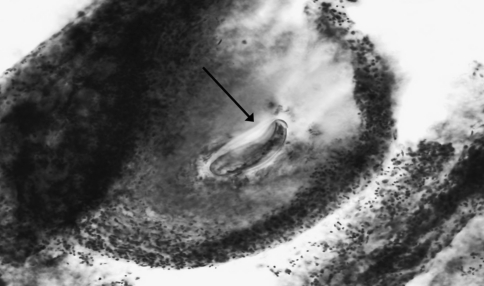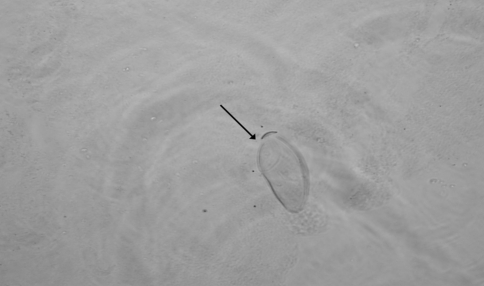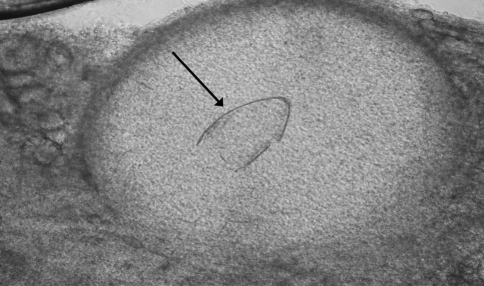Abstract
Fascioliasis is a zoonose parasitic disease caused by Fasciola hepatica and Fasciola gigantica and is widespread in most regions of the world. Ectopic fascioliasis usually caused by juvenile Fasciola spp., but in recent years a few cases of tissue-embedded ova have been reported from different endemic areas. A 79-year-old Iranian man resident in Eird-e-Mousa village from Ardabil Province, north-west of Iran, complained with abdominal pain, nausea, and intestinal obstruction symptoms referred to Ardabil Fatemi hospital. In laparotomy multiple intestinal masses with peritoneal seeding resembling of a malignant lesion were seen. After appendectomy and peritoneal mass biopsy with numerous intraperitoneal adenopathy, paraffin embedded blocks were prepared from each tissues. A blood sample was taken from the patient 5 months later for serological diagnosis. Histopathological examination of sections showed fibrofatty stroma with dense mixed inflammatory cells infiltration and fibrosis in peritoneal masses. Large numbers of ova of Fasciola spp. were noted with typical circumscribed granulomas. Despite of anti-fasciola treatment, IHA test for detecting anti F. hepatica antibodies was positive 5 months after surgery with a titer of 1/128. Due to multiple clinical manifestation of extra-hepatic fascioliasis, its differential diagnosis from intraperitoneal tumors or other similar diseases should be considered.
Keywords: Extra-hepatic fascioliasis, Peritoneal tumor, Ardabil, Iran
Introduction
Fascioliasis is a zoonose parasitic disease caused by Fasciola hepatica and Fasciola gigantica and is widespread in most regions of the world. Human infection occurs by ingesting of encysted metacercariae associated with aquatic or semi-aquatic plants, or by contaminated drinking water with float metacercariae (WHO 2011). Fascioliasis is a major health problem especially in north of Iran (Mas-Coma et al. 1999; Eslami et al. 2009). Ectopic fascioliasis usually caused by juvenile Fasciola spp. (Lee et al. 1982; Chang et al. 1991; Zali et al. 2004; Yi-Zhu and Zhi-Bang 2010), but in recent years a few cases of tissue-embedded ova have been reported from different areas (Yazici et al. 2005; Naresh et al. 2006; Makay et al. 2007; Marcos et al. 2009; Ongoren et al. 2009). In this report, an unusual manifestation of ectopic fascioliasis in peritoneum is presented.
Materials and methods
A 79-year-old Iranian man resident in Eird-e-Mousa village from Ardabil Province, north-west of Iran, complained with abdominal pain, nausea, and intestinal obstruction symptoms referred to Ardabil Fatemi hospital. The patients had reported a history of occasional mild abdominal pain within the last 6 months. In blood examination the white blood cells count was 16,200/mm3 and other parameters were normal. Urine analyses did not show any abnormality. The patient was operated with impression of intestinal obstruction. In laparotomy multiple intestinal masses with peritoneal seeding resembling of a malignant lesion were seen. Moreover local intestinal necrosis and multiple lymphadenopathies were noticed.
After appendectomy and peritoneal mass biopsy with numerous intraperitoneal adenopathy, paraffin embedded blocks were prepared from each tissues. Briefly, tissue samples from the mass were fixed in 10% formalin, processed routinely and sections were stained with hematoxylin and eosin (H&E). Considering that Fasciola infection is not endemic in human in Ardabil Province, the serological test had not been performed at the time of admission or just after the surgery, and the treatment was performed by administration of triclabendazole 10 mg/kg twice daily at 12 h interval according to finding of Fasciola spp. ova in pathological examination. A blood sample was taken from the patient 5 months later for serological diagnosis. Consumption of streamlet row vegetables such as watercress was usual in patient’s habitat.
Results and discussion
Histopathological examination of sections showed fibrofatty stroma with dense mixed inflammatory cells infiltration and fibrosis in peritoneal masses. The inflammatory cells were consists of lymphoplasma cells and abundant eosinophils. Large numbers of ova of Fasciola spp. were also noted with typical circumscribed granulomas (circumoval granulomas) (Figs. 1, 2, 3). A few circumscribed granulomas were also noted on the serosa of appendix and perinodal soft tissues. Despite of anti-fasciola treatment, IHA test for detecting anti-fasciola antibodies was positive 5 months after surgery with a titer of 1/128. Patient had no complaints of abdominal pain or other related symptoms 5 months after the treatment.
Fig. 1.
Circumoval granulomas with operculated egg of Fasciola spp. stained with hematoxylin and eosin
Fig. 2.
Tissue-embedded operculated egg of Fasciola spp. (unstained)
Fig. 3.
Pressured smear (between two slides) shows Fasciola egg wall in peritoneal mass
While both F. hepatica and F. gigantica live in the large biliary tracts and gallbladder normally and are the cause of histopathologic effects in these organs, extra-hepatic fascioliasis was documented in different organs of human especially in endemic areas (Zali et al. 2004; Naresh et al. 2006; Vatsal et al. 2006; Ongoren et al. 2009; Yi-Zhu and Zhi-Bang 2010). Some reports have confirmed the migration of juvenile Fasciola spp. (Lee et al. 1982; Chang et al. 1991), also existence of gravid Fasciola in some organs was reported based on observation of tissue-embedded ova (Yazici et al. 2005; Naresh et al. 2006; Makay et al. 2007; Ongoren et al. 2009).
In this report high numbers of Fasciola spp. ova were diagnosed in circumscribed granulomas from peritoneum and intestine wall. Operculated ova had same size range of Fasciola spp. (>130 μm).
Observation of many operculated ova with >130 μm length in circumscribed granulomas, beside other histopathological findings such as the abundant eosinophils in granulomas, and also detection of anti-fasciola antibody by IHAT helped us to diagnosis Fasciola spp. as a causative agent for the patient.
Due to multiple clinical manifestation of extra-hepatic fascioliasis, its differential diagnosis from intraperitoneal tumors or other similar diseases should be considered. Moreover because of existence of Fasciola spp. infection in sheep in this area and considering the food habits of residents, for using streamlet row vegetables, further surveys are needed for determination of fascioliasis prevalence in this area.
Acknowledgments
The authors would like to thank Professor I. Mobedi and Professor S. M. Sadjjadi for their kindly assistance and confirmation of morphologic diagnosis of tissue-embedded Fasciola spp. ova.
References
- Chang EC, Choi HL, Park YW, Kong Y, Cho SY. Subcutaneous fascioliasis: a case report. Kisaengchunghak Chapchi. 1991;29(4):403–405. doi: 10.3347/kjp.1991.29.4.403. [DOI] [PubMed] [Google Scholar]
- Eslami A, Hosseini SH, Meshgi B. Animal fasciolosis in north of Iran. Iran J Public Health. 2009;38(4):132–135. [Google Scholar]
- Lee SH, Cho SY, Seo BS, Choe KJ, Chi JG. A human case of ectopic fascioliasis in Korea. Kisaengchunghak Chapchi. 1982;20(2):191–200. doi: 10.3347/kjp.1982.20.2.191. [DOI] [PubMed] [Google Scholar]
- Makay O, Gurcu B, Caliskan C, Nart D, Tuncyurek M, et al. Ectopic fascioliasis mimicking a colon tumor. World J Gastroenterol. 2007;13(18):2633–2635. doi: 10.3748/wjg.v13.i18.2633. [DOI] [PMC free article] [PubMed] [Google Scholar]
- Marcos LA, Legua P, Sanchez J, Espinoza JR, Yi P, et al. Cervical tumor caused by the sexually mature stage of Fasciola hepatica. Trans R Soc Trop Med Hyg. 2009;103(3):318–320. doi: 10.1016/j.trstmh.2008.10.024. [DOI] [PubMed] [Google Scholar]
- Mas-Coma MS, Esteban JG, Bargues MD. Epidemiology of human fascioliasis: a review and proposed new classification. Bull World Health Organ. 1999;77(4):340–346. [PMC free article] [PubMed] [Google Scholar]
- Naresh G, Gomez PA, Salmah B, Suryati MY. Fasciolosis (liver fluke) of the breast in a male patient: a case report. Breast. 2006;15(1):103–105. doi: 10.1016/j.breast.2005.02.009. [DOI] [PubMed] [Google Scholar]
- Ongoren AU, Ozkan AT, Demirel AH, Ustun H, Donmez M. Ectopic intra-abdominal fascioliasis. Turk J Med Sci. 2009;39(5):819–823. [Google Scholar]
- Vatsal DK, Kapoor S, Venkatesh V, Vatsal P, Husain N. Ectopic fascioliasis in the dorsal spine: case report. Neurosurgery. 2006;59(3):706–707. doi: 10.1227/01.NEU.0000230247.42067.6C. [DOI] [PubMed] [Google Scholar]
- WHO (2011) 64th world health assembly. Neglected tropical diseases, Geneva, Switzerland, 16–24 May 2011. http://www.who.int/neglected_diseases/diseases/fascioliasis/en/
- Yazici G, Dilek UT, Karabacak T, Ertunc D, Korkmaz M, et al. Adnexal fascioliasis masquerading as ovarian cancer. Gynecol Oncol. 2005;99(1):236–238. doi: 10.1016/j.ygyno.2005.06.016. [DOI] [PubMed] [Google Scholar]
- Yi-Zhu X, Zhi-Bang Y. A case of ectopic fascioliasis in the skin. Trop Doct. 2010;40(4):253–254. doi: 10.1258/td.2010.090445. [DOI] [PubMed] [Google Scholar]
- Zali MR, Ghaziani T, Shahraz S, Hekmatdoost A, Radmehr A. Liver, spleen, pancreas and kidney involvement by human fascioliasis: imaging findings. BMC Gastroenterol. 2004;4:15. doi: 10.1186/1471-230X-4-15. [DOI] [PMC free article] [PubMed] [Google Scholar]





